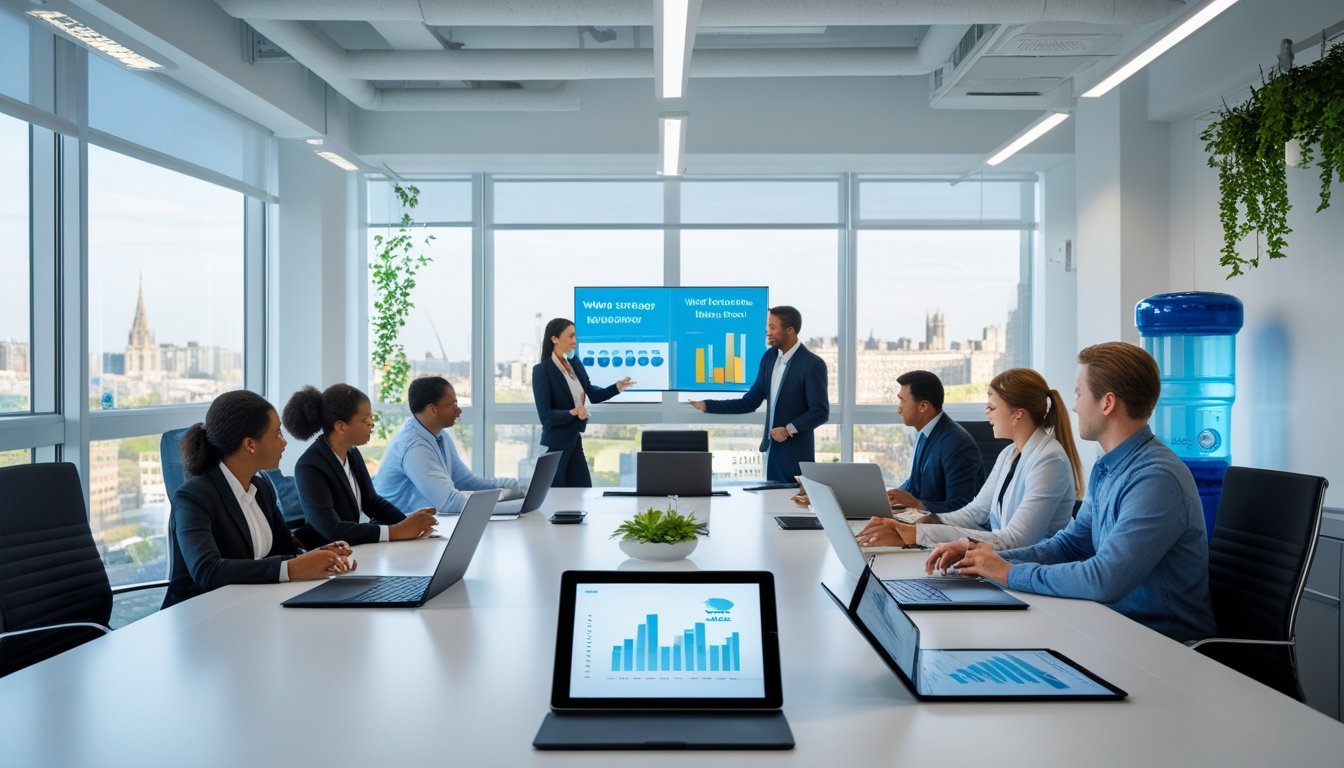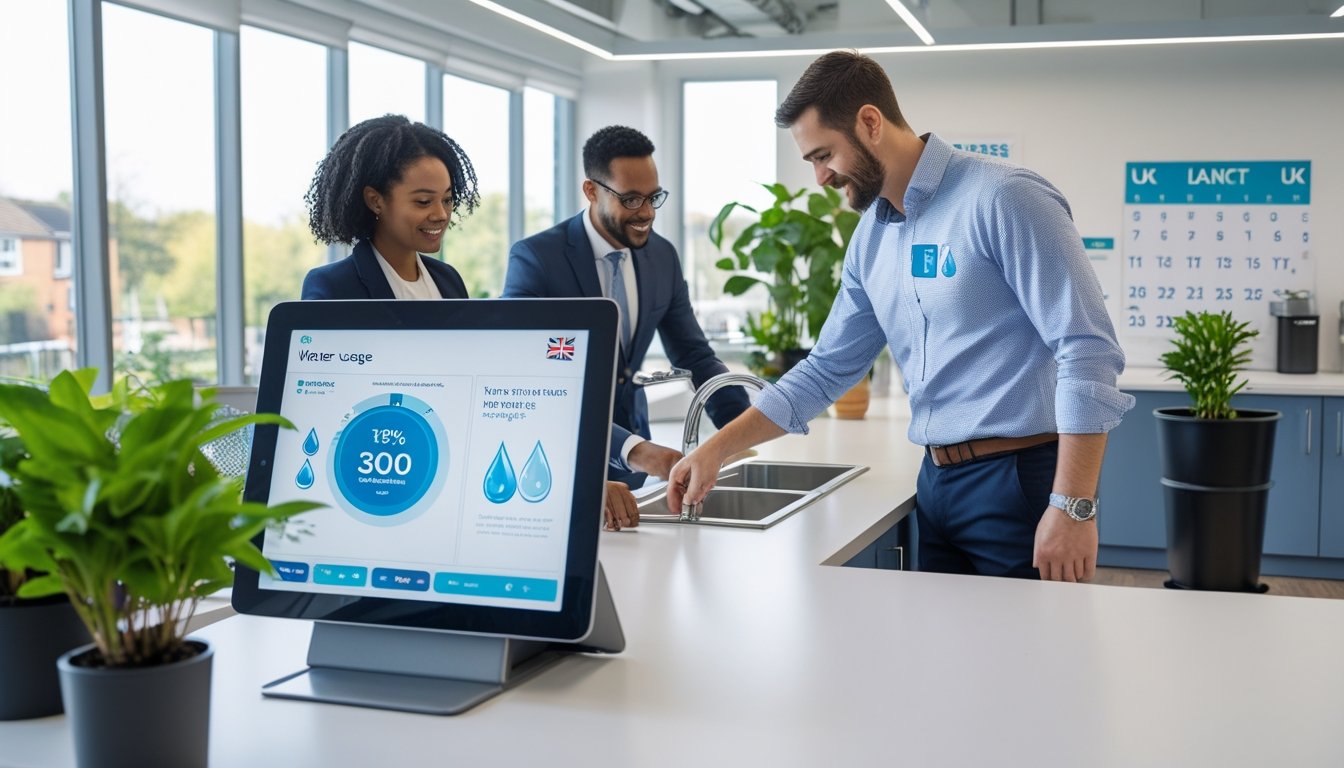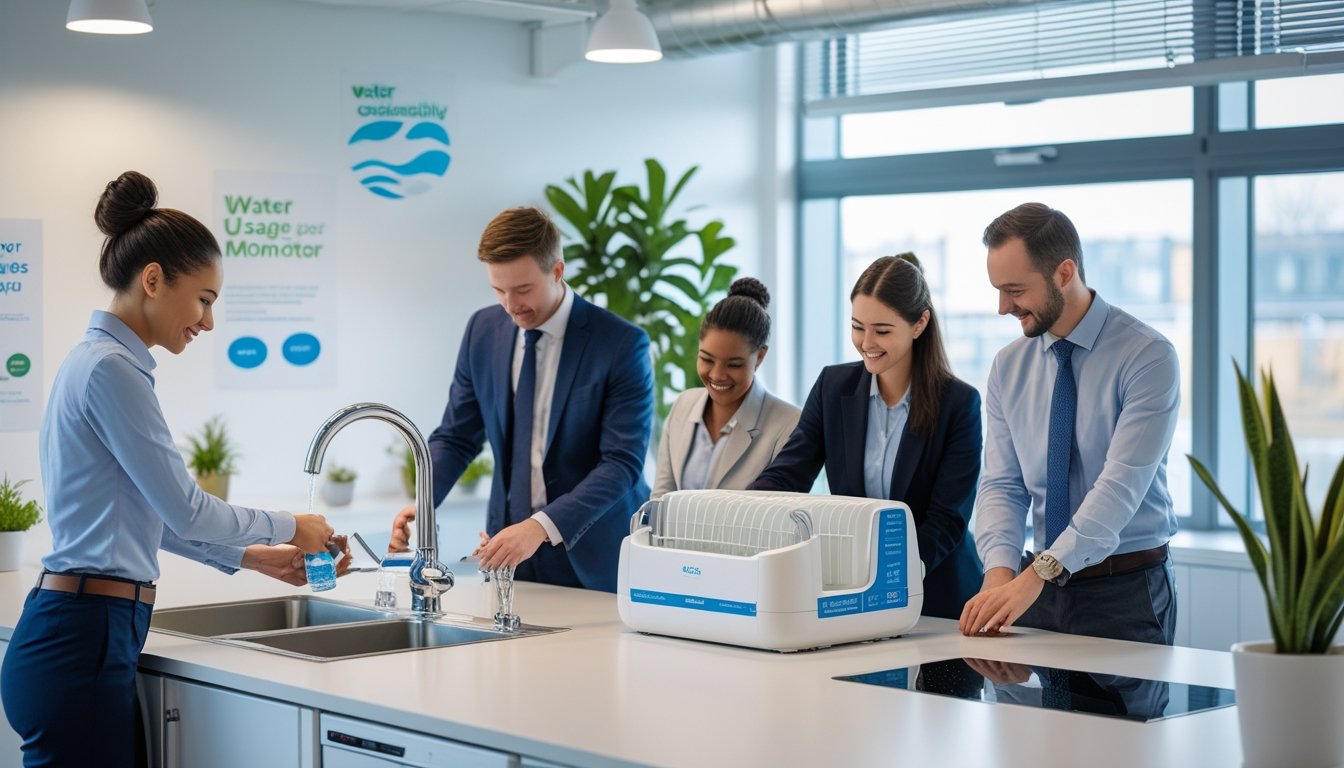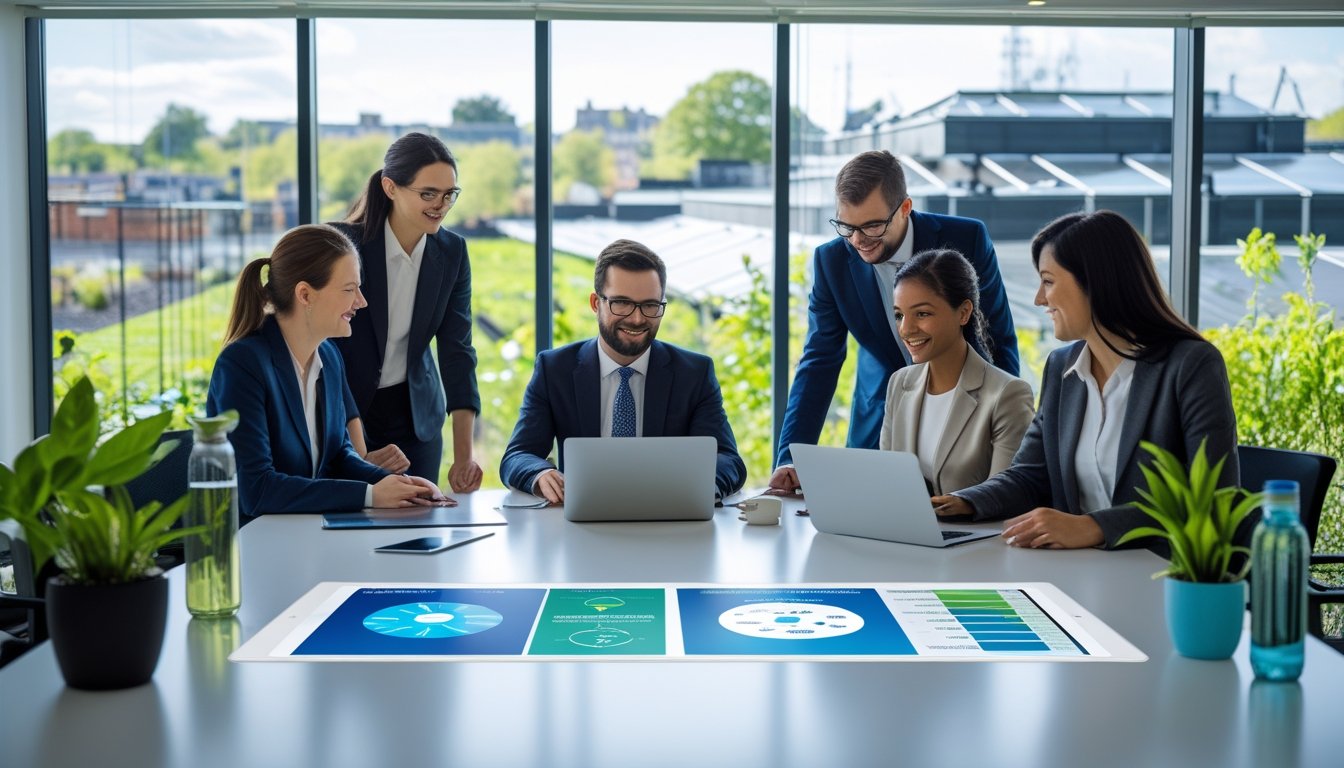Late updated: 23 Sep 2025 12:09
Written by: Amber Collins
Reducing Office Water Usage In The UK: Strategies For Efficiency
Reducing office water usage in the UK is not just a financial necessity but an environmental imperative. By adopting effective water-saving strategies, businesses can significantly cut operational costs and contribute to environmental sustainability. The growing challenges posed by climate change and increasing water demand make it essential for UK offices to act.

Water conservation goes beyond fixing leaks and installing water-efficient fixtures. We must encourage a culture of awareness and responsibility among employees, promoting habits that minimise waste. Our commitment to efficient water usage safeguards our finances and environment and ensures resources for future generations.
Blending practical solutions with long-term strategies enhances business resilience. Innovations, such as smart meters and recycled water systems, offer additional avenues to manage consumption effectively. Our journey towards reduced water usage must be collaborative, with everyone playing a pivotal role.
Key Takeaways
- Implement effective water-saving strategies.
- Encourage a culture of water responsibility in the office.
- Embrace innovations for greater water efficiency.
Key Strategies for Reducing Office Water Usage

In the UK, conserving water in the workplace is essential for both environmental sustainability and cost reduction. By focusing on efficient water management and technology upgrades, offices can significantly cut down on water usage. Let’s explore some effective strategies to achieve this goal.
Understanding and Monitoring Water Usage
Setting up a baseline for current water consumption is vital. We recommend using smart meters or sub-metering systems to track water usage across different areas within the office. Regular monitoring helps identify any anomalies or sudden spikes in usage, indicating potential issues such as leaks or inefficient fixtures.
With real-time data, we can pinpoint problem areas and address them swiftly. This proactive approach not only saves water but also reduces operational costs. Staff should be encouraged to report any irregularities in water usage, ensuring that issues are identified quickly.
Upgrading to Water-Efficient Fixtures
Installing water-efficient taps and toilets can drastically decrease water consumption. Modern fixtures such as low-flow taps and dual-flush toilets are designed to use significantly less water without sacrificing performance.
Additionally, upgrading to an efficient showerhead in office showers can reduce water flow by up to 50%. Investing in smart fixtures with sensors can also prevent water wastage by controlling flow based on usage needs. We can achieve sustainable water use by choosing products rated for efficiency, such as those with a Water Efficiency Product Labelling Scheme (WEPLS) rating.
Addressing Leaks and Damp Patches
Leaks and damp patches are silent culprits of excessive water usage. Routine inspections of plumbing systems are crucial to identify and fix leaks quickly. We should prioritise fixing dripping taps, leaking toilets, and any visible damp patches on walls or floors.
A proactive leak detection system can offer an added layer of security by providing immediate alerts when water anomalies are detected. By dealing with leaks promptly, we safeguard against water loss and potential damage to office infrastructure, saving water and costs in the long run.
Optimising Kitchens, Toilets, and Showers
Kitchens and toilets are common areas where water usage peaks in an office setting. In kitchen areas, installing aerators in taps and encouraging staff to only run dishwashers with full loads can conserve water.
In toilets, signs reminding users to use water wisely promote awareness. Offices with showers can invest in timer systems to limit water use. Regular maintenance of appliances like dishwashers and toilets ensures they operate efficiently, preventing unnecessary water wastage. These practices help maintain a water-efficient environment, contributing to reduced water bills and a more sustainable workplace.
Implementing Practical Water-Saving Measures

Reducing water usage in the office requires a combination of employee engagement, smart technology, and sustainable practices. Promoting Employee Awareness, Installing Shower Timers and Controls, and Rainwater Harvesting for Offices are steps that can help us achieve significant savings.
Promoting Employee Awareness
Creating a water-conscious culture starts with raising employee awareness. By organising workshops and training sessions, we can effectively educate our team about the importance of saving water. Visual aids like posters reminding employees to turn off taps and reporting leaks promptly can also be helpful.
In addition, implementing a feedback system encourages staff to suggest water-saving ideas, fostering a proactive environment. We should also provide regular updates on water usage, which can motivate everyone to contribute to conservation efforts.
Installing Shower Timers and Controls
Installing shower timers is a straightforward approach to manage water usage, especially in offices with shower facilities. Timers can be set to limit shower durations, preventing unnecessary water waste. Advanced controls can also adjust temperature and flow, ensuring efficiency without compromising on comfort.
Using smart technology like motion sensors or programmable systems can further enhance water efficiency. We must evaluate our specific needs to choose the best solution, balancing usability with conservation. By adopting these measures, we support both ecological sustainability and cost savings.
Rainwater Harvesting for Offices
Implementing rainwater harvesting systems provides a sustainable alternative for non-potable water needs. Collecting rainwater from roofs and filtering it for use in toilets, irrigation, or cleaning can significantly reduce our reliance on mains water.
This system not only conserves water but also decreases our environmental footprint. When setting up rainwater harvesting, it's essential to ensure compliance with local regulations and to maintain the system regularly. By integrating these solutions, we can foster a more eco-friendly workplace while reducing operational costs.
Frequently Asked Questions

To effectively reduce water consumption in UK offices, it's crucial to consider strategies, behavioural shifts, regulatory frameworks, devices, audits, and employee engagement initiatives. Each of these elements can contribute significantly to more sustainable water usage in corporate environments.
What are the most effective strategies for reducing water consumption in UK office buildings?
Implementing water-efficient fixtures, monitoring usage with smart meters, and fixing leaks promptly are highly effective strategies. Using drought-resistant landscaping and efficient irrigation systems can also help reduce water use in office buildings.
How can behavioural changes contribute to lower water usage in corporate environments?
Encouraging staff to report leaks and be mindful of water use can significantly lower consumption. Simple actions, such as turning off taps while washing hands or reducing flush volumes, create a more water-conscious workplace.
What are the regulations governing water conservation in UK workplaces?
The UK has regulations requiring businesses to monitor and manage their water use. Companies must comply with standards for water safety and efficiency, including obligations to prevent waste and misuse as guided by the Water Act and other legislation.
Can you suggest some water-saving devices suitable for office restrooms and kitchens?
Installing low-flow taps and toilets, dual-flush systems, and tap aerators can significantly reduce water usage. In kitchens, consider using water-efficient dishwashers that consume less water while maintaining performance.
What is the role of water audits in managing consumption within UK office premises?
Water audits help identify areas where water can be saved. They provide insights into usage patterns, highlight inefficiencies, and suggest areas for improvement. Conducting regular audits ensures continuous water conservation efforts.
How can businesses in the UK engage employees in initiatives to save water at work?
Creating awareness through workshops and training sessions can encourage employees to save water. Establishing suggestion schemes or competitions focused on water conservation can foster a culture of sustainability and shared responsibility.
